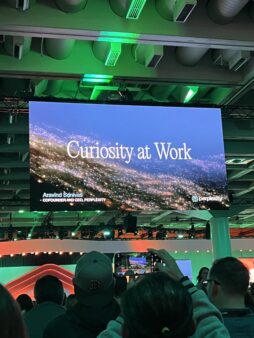AI is the new OS — but marketers’ curiosity will decide its value
At HubSpot's Inbound, the talk of AI was everywhere, but the brands that thrive will balance AI tools with curiosity-driven strategies.
AI hype is following a well-worn path. During the dot-com boom, we were promised the internet would bring an overnight revolution. While it was revolutionary, some changes arrived quickly, but most unfolded over years, marked as much by failures and false starts as by lasting breakthroughs.
I was at Inbound in San Francisco last week, and the AI hype was overwhelming. Conversations were either focused solely on the tactical use of AI or, interestingly, on reframing AI in our minds.
AI as the new OS
AI is quickly becoming the infrastructure layer of modern business.
In his keynote, Dario Amodei, CEO of Anthropic, called it an operating system, much like cloud computing. Adoption isn’t theoretical anymore. Usage is widespread across roles and industries. In pharma, legal and manufacturing, AI reduces friction at a scale humans can’t match. For example, innovative manufacturers now use AI to detect user context to serve different experiences automatically and are accelerating their use of AI to mine for insights.
Dig deeper: Sharing AI wins and fails will save marketers from repeating mistakes
Claude and other assistants are already reshaping organizational productivity, accelerating code and content creation through automated drafting and suggestions. But lessons from the past ring loudly in my memory. Not every shiny demo is ready for prime time. How many incredible demos and keynotes have resulted in less-than-stellar real-world applications and features?

An OS must be reliable before it can be transformative.
Curiosity makes AI valuable
AI is powerful, but curiosity makes it valuable. AI provides scale, but curiosity provides depth.
Aravind Srinivas, CEO of Perplexity, reminded us that progress often begins with the questions nobody dares to ask. Eric Bailey, president of Bailey Strategic Innovation Group, pushed further, showing how our brains trick us with certainty when what we need instead is professional not-knowing, a disciplined willingness to lead through inquiry rather than assumption. Beth Dunn, head of product experience at Agent.ai (a network for AI Agents), reframed curiosity as an act of empathy, a way of listening that deepens connection.
Curiosity isn’t just a trait. It’s the basis for learning, trust and innovation.
Human truths and creative courage
Curiosity isn’t abstract. It shows up in how teams handle fear, failure and resistance.
Amy Poehler talked about thanking fear before moving past it in her closing keynote. Failure, she argued, isn’t just a setback. It creates the conditions that make learning possible. The best teams value big swings over safe bets.
Dig deeper: 3 ways AI is changing how people shop, marketers work and stacks evolve
In my session “Stop Fighting Resistance—Start Using It,” I saw curiosity helping groups overcome resistance and build momentum. One attendee worked through a simple framework that enabled her to reframe her resistance to updating old website content. Another realized their resistance was coming from something unrelated to work, and reframing the issue led to a breakthrough in thinking.
Without curiosity, AI is a stochastic parrot. All it can do is find the most likely used word, number or color for a particular situation.
A necessary caution
AI alone produces speed without meaning, and curiosity alone generates meaning without momentum. Many leaders will default to automation or reflection for various reasons: FOMO (fear of missing out on AI), pressure from management/board to do something rather than nothing, personal comfort and/or skill gaps in talent. Any of those leaves value on the table or leads to missed opportunities. AI without curiosity leads to irrelevant noise, and curiosity without AI leads to brilliant ideas that never scale.
Senior marketers are told to move fast, automate and scale. But speed without depth is empty. Curiosity makes scale meaningful. The companies that thrive won’t be the ones that adopt every AI tool. They’ll be the ones that design for both: optimizing stacks for efficiency while cultivating cultures that reward curiosity.
Recommendations for senior marketers
- Pair efficiency with inquiry: Build AI and automation roadmaps alongside a portfolio of open questions teams are expected to explore. Think brainstorming sessions, shared collaboration tools, hackathons.
- Redefine KPIs and reward curiosity: Balance throughput and engagement metrics with learning metrics such as new customer insights surfaced or hypotheses tested. Make experimentation and asking hard questions part of performance reviews. Consider a “failed experiment count,” or shared prompt libraries and examples.
- Design for identity and reliability: Treat AI as infrastructure and avoid scaling unstable tools. Shift from channel hacks to identity-aware strategies, using what you know about individuals to shape communication and trust. One way to achieve this is to shift focus from constantly seeking new tools to building shared momentum and language around a set of standardized platforms. You should choose these platforms for their ability to allow for personalization and customization.
Contributing authors are invited to create content for MarTech and are chosen for their expertise and contribution to the martech community. Our contributors work under the oversight of the editorial staff and contributions are checked for quality and relevance to our readers. MarTech is owned by Semrush. Contributor was not asked to make any direct or indirect mentions of Semrush. The opinions they express are their own.
Related stories